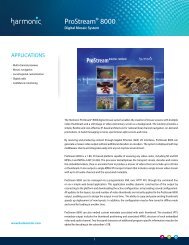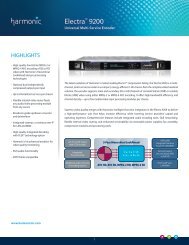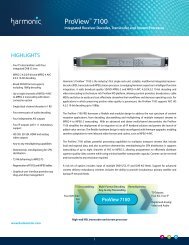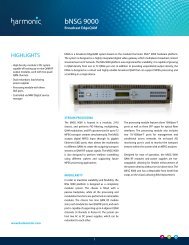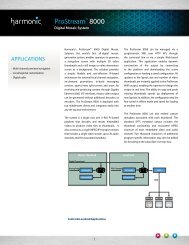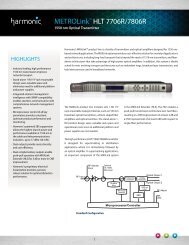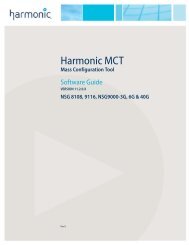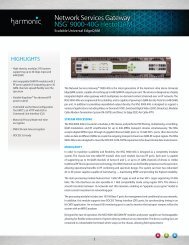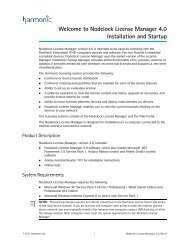NSG 9000-6G - Harmonic Inc
NSG 9000-6G - Harmonic Inc
NSG 9000-6G - Harmonic Inc
Create successful ePaper yourself
Turn your PDF publications into a flip-book with our unique Google optimized e-Paper software.
Chapter 3 Configuring Platform Parameters<br />
Configuring/Viewing DTI Parameters<br />
<br />
port fails, the standby port is activated and assumes the role of "active" as long as it is<br />
in normal state. If the latter fails, ports will be switched again. This switching can<br />
continue any number of times, without any preference of a specific port.<br />
Automatic (Auto Revert) - in this mode, the selected port (as defined in Selected Port)<br />
is always preferred over the other port. In case that the selected port fails, the<br />
standby port is automatically activated. Once the selected port is fixed, the <strong>NSG</strong><br />
automatically switches back to the selected port.<br />
5. To select the active DTI port, open the Selected Port list and select either port 1 or 2.<br />
NOTE: The Selected Port list is disabled if Automatic (no Auto Revert) is selected.<br />
6. In Notification, define which notification to send once the status of the DTI client changes:<br />
<br />
<br />
Log Status Change Events - send a notification to the alarm log upon a change in the<br />
status of the DTI client<br />
Send Trap on Status Change - send an SNMP trap upon a change in the status of the<br />
DTI client<br />
3.11.2 Viewing DTI Client and DTI Port Information<br />
1. Select the Platform > General tab.<br />
2. In the In Back Panel View, select the DTI component.<br />
NOTE: The DTI section is enabled only when a DTI client is installed in the device.<br />
The General tab appears.<br />
3. To view DTI client information, focus on Client Information section.<br />
<br />
In Overall Status, verify that the DTI status is NORMAL. The following table lists the<br />
available Status options:<br />
Table 3-5: DTI Client State Options<br />
Status<br />
Warmup<br />
Freerun<br />
Normal<br />
Bridging<br />
Holdover<br />
Fast<br />
Explanation<br />
Local oscillator has not yet stabilized<br />
DTI client is not locked to the signal of the DTI server, and is running<br />
freely using its own internal real-time clock. Freerun indicates that since<br />
its last initialization, the client was not locked to the server.<br />
DTI client is locked to the DTI server, working normally<br />
This is a transient state, which may last up to 2 seconds. It indicates that<br />
the DTI client has experienced a momentary interruption in its timing<br />
signal, but is still able to maintain acceptable timing. <strong>NSG</strong> <strong>9000</strong> is still<br />
locked to the DTI server clock.<br />
DTI client lost its sync to the DTI server clock. Working in "best effort<br />
mode", with the last known valid time correction<br />
The DTI client has just acquired a valid signal, and is in the process of<br />
locking to it. If this status is displayed for a prolonged time, this<br />
indicates a problem with the received DTI signal or with the DTI client.<br />
<br />
<br />
In 10Mhz Ref., indicates whether the 10Mhz Reference signal is present.<br />
In Timestamp, view the last DTI timestamp<br />
© 2012 <strong>Harmonic</strong> <strong>Inc</strong>. 40 <strong>NSG</strong> <strong>9000</strong>-<strong>6G</strong>, Version 2.7, Rev B



